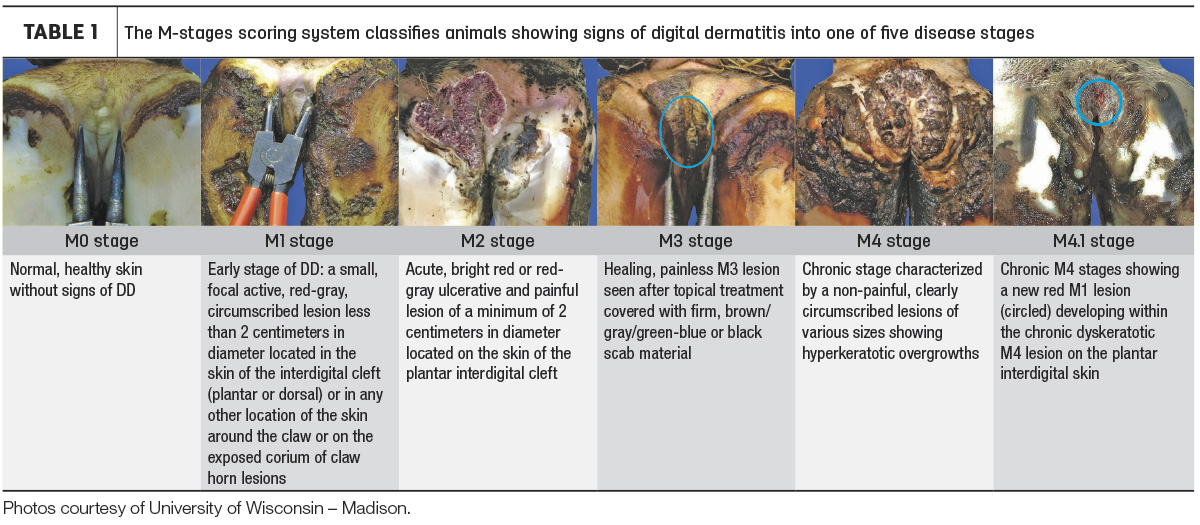Perhaps one of the most frustrating things about raising cattle is when a producer goes out to feed or does a pasture check and finds cattle limping or struggling to get around. As they begin to assess the situation, various possibilities come to mind: Could it be a traumatic injury? Foot rot? Is something tangled around the foot? No matter the cause, it will likely require the producer to get the affected individuals into a restraining chute for further inspection. Unfortunately, there is a new disease that has emerged in the past decade in beef cattle operations that producers need to be on the outlook for.
Digital dermatitis (DD) is a condition that was first described on dairy farms in the 1970s. It is often characterized by red, ulcerative lesions, predominantly found on the back feet of cattle. These lesions can sometimes become proliferative and have hairlike tissue growing out from the affected areas of the foot. These visible appearances have led to common names to describe the disease such as heel warts, hairy heel warts and strawberry warts. While prevalent in dairy operations for over 50 years, there has been a notable increase in hairy heel wart incidents on dairy farms in the past 15 years. Moreover, beef feedlots, particularly in the Midwest, have also seen a rapid rise in occurrences during the same period. It is important to know what DD looks like so appropriate action can be taken if it is present on your farm.
Detriment to health and mobility
Hairy heel warts are a type of skin infection that can severely compromise the overall health and mobility of cattle. These infections typically manifest as lesions, accompanied by redness, swelling and foul-smelling discharge. Often, the swelling will not be symmetrical in the foot like it is when observed in foot rot. The swelling will vary from side to side in the foot and often will not migrate up into the top of the foot. These painful lesions cause cattle to avoid putting pressure on the affected area, often resulting in them walking on their toes, a behavior sometimes referred to as the “ballerina dance.”
The cause of DD is thought to be complex and affected by multiple factors. However, a spirochete bacteria known as treponema is thought to be the primary culprit behind digital dermatitis. It is believed that the bacteria can penetrate the foot through either compromised skin tissue or through the hair follicles and sebaceous glands in the foot. Once they penetrate the skin, the bacteria release enzymes that cause skin damage, hemorrhage and a considerable amount of pain. It does not appear that treponema bacteria live a long time in manure or slurry, which would give us hope that keeping clean pen conditions would prevent this problem. However, the problem continues to grow.
It is hypothesized that the main source of bacteria is coming from currently affected cattle in the herd or pen. This is why once an animal is diagnosed, the common theme is to observe DD spread quite quickly through the rest of the herd. This, too, differs from the way foot rot is observed on-farm. Normally, once cattle are diagnosed with foot rot and are treated, there is minimal risk to the rest of the herd or pen. Furthermore, DD does not respond to systemic antibiotics delivered through a needle injection. While research is still limited with various products assessed for treatment of DD, it appears that topical treatment is the only one that is effective for afflicted individuals. This requires producers to have the ability to pick up the foot and apply the treatment. This treatment method very quickly becomes impractical for a whole herd or pen of animals.
Know thy enemy
Any compromise in hoof health can lead to lameness, affecting the cattle’s ability to graze, mate or gain weight. For producers who have the misfortune of having to deal with hairy heel warts, it is important to assess where individual animals – as well as the herd or pen – are in terms of the life cycle of the disease. The M-stages scoring system, developed by Dörte Döpfer from the University of Wisconsin – Madison, is an effective way to diagnose and monitor digital dermatitis. This system classifies animals showing signs of digital dermatitis into one of five disease stages: M1, M2, M3, M4 and M4.1. In addition, healthy digital skin is classified as M0 (see Table 1).

This classification system can aid producers and veterinarians in developing a game plan for helping break the cycle of digital dermatitis.
Don’t bury your head in the sand – hairy heel warts are here to stay
In conclusion, the significance of hoof health in beef cattle management cannot be overstated. Hairy heel warts pose a formidable threat to both individual animal welfare and the economic sustainability of beef operations. Proactive measures, including vigilant monitoring and quickly addressing any problems to managing these infections are critical. Visit with your veterinarian to discuss their expertise on the disease and their current treatment protocols.










